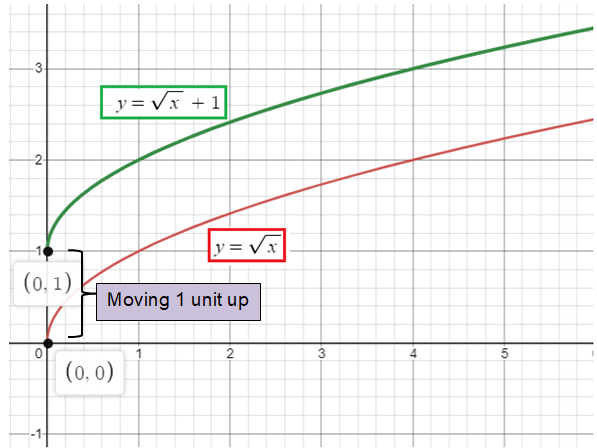GRAPHING SQUARE ROOT FUNCTIONS
The radical function in the form y = √(x - a) + b can be graphed easily by comparing with the graph of parent function y = √x
Domain :
The domain is all possible value of x.
For √x, domain is x≥0.
Horizontal translation :
Horizontal translation is shifting the base graph left or right in the direction of the x-axis.
- In √(x - a), we move the parent function a units to the right
- In √(x + a), we move the parent function a units to the left.
Vertical translation :
Horizontal translation is shifting the base graph up or down in the direction of the y-axis.
- In √x + b, we move the parent function b units up.
- In √x - b, we move the parent function b units down.
Horizontal or vertical compressions :
Given a function f(x), a new function g(x) = a g(x) where a is a constant.
- If a > 1, then the graph will be stretched
- If 0 < a < 1, then the graph will be compressed.
- If a < 0, then there will be reflection.
Intercepts :
To find x-intercept, we will put y = 0 and solve for x.
To find y-intercept, we will put x = 0 and solve for y.
Graph each of the function given below.
Example 1 :
y = √x + 1
Solution :
By considering the parent function y = √x
1 is added along with the parent function, so there is vertical translation. We have to move the graph 1 unit up.

Example 2 :
y = √x - 2
Solution :
By considering the parent function y = √x
2 is subtracted from the parent function, so there is vertical translation. We have to move the graph 2 units down.

Example 3 :
y = √(x - 3)
Solution :
By considering the parent function y = √x
3 is subtracted from x, so there will be a horizontal translation.
We have to move the graph, 3 units to the right.

Example 4 :
y = 3√(x + 1) + 4
Solution :
By considering the parent function y = √x
1 is added with x, so we have to perform horizontal translation. Move the graph 1 unit to the left.
4 is added with the parent function, so we have to perform vertical translation. Move the graph 4 units up.
3 is multiplied with the parent function, we have to stretch 3 units.
|
x intercept : Put y = 0 0 = 3√(x + 1) + 4 -4/3 = √(x + 1) There is no x-intercept. |
y intercept : Put x = 0 y = 3√(0 + 1) + 4 y = 3 + 4 y = 7 (0, 7) |

Recent Articles
-
Finding Range of Values Inequality Problems
May 21, 24 08:51 PM
Finding Range of Values Inequality Problems -
Solving Two Step Inequality Word Problems
May 21, 24 08:51 AM
Solving Two Step Inequality Word Problems -
Exponential Function Context and Data Modeling
May 20, 24 10:45 PM
Exponential Function Context and Data Modeling